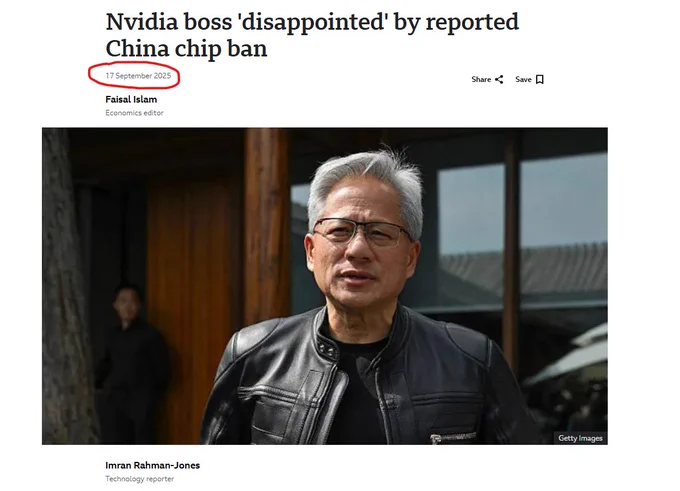Disruptive Tech and Stock Market Catalysts Attention Is All You Need
Joined September 2025
- Tweets 1,208
- Following 468
- Followers 129
- Likes 1,372
Pinned Tweet
How is the stock market looking now after the Trump and Xi Jinping deal? #StockMarket #China #aibubble
The King and the Queen #stockmarket
As nations race to define the next technological frontier, China is making strategic bets across multiple advanced sectors, from artificial intelligence that rivals Western counterparts to quantum systems that have entered commercial deployment. These developments, coupled with unprecedented growth in renewable energy capacity, suggest a nation executing a comprehensive innovation strategy with global implications.
● AI Advancements: Open Source and Human-Centric Approach
China's artificial intelligence sector is increasingly focused on advanced reasoning capabilities. Chinese AI lab DeepSeek recently released its R1 model family under an open MIT license, featuring 671 billion parameters and claiming performance that rivals OpenAI's o1 model. This open-source approach has positioned Chinese models prominently in global rankings, with companies like DeepSeek and Alibaba delivering world-class performance that challenges traditional Western dominance.
Notably, China's AI development model has largely avoided the workforce disruptions seen elsewhere. While Western tech giants implemented significant layoffs during AI transitions, Chinese companies have maintained stable employment while pursuing cutting-edge research—a strategy that prioritizes human capital alongside technological advancement.
● Robotics Revolution: XPENG's Humanoid Breakthrough
The convergence of AI and robotics is particularly evident in XPENG's next-generation IRON humanoid robot. This advanced machine integrates three in-house developed Turing AI chips, delivering a combined computing power of 2,250 TOPS to drive sophisticated vision-language-action capabilities. The robot's engineering features bionic muscles and a human-like spine, representing a significant leap in physical AI interaction.
XPENG's achievement marks a critical milestone in China's push toward practical robotics applications. The company plans to enter mass production of the IRON robot by 2026, positioning China at the forefront of the humanoid robotics race alongside global competitors. This development underscores China's commitment to vertical integration, designing everything from AI chips to end-user applications within domestic ecosystems.
● Quantum Computing: Dual Breakthroughs in Commercialization
China's quantum computing efforts are advancing on multiple technological fronts with remarkable speed. The nation has deployed a superconducting quantum computer based on the "Zuchongzhi 3.0" design for commercial use, marking a crucial step toward practical quantum applications. This system, built with 105 readable qubits and 182 couplers, represents one of the world's most advanced quantum processors ready for real-world deployment.
Simultaneously, China's first atomic quantum computer, the Hanyuan-1, has achieved its initial commercial sales with orders surpassing US$5.6 million. These commercial orders include contracts with China Mobile's subsidiary and international customers like Pakistan, demonstrating both domestic adoption and global market appeal. The dual-track approach—pursuing both superconducting and atomic quantum technologies—reflects China's comprehensive strategy to dominate multiple quantum computing paradigms.
● Green Energy: Unprecedented Scale and Speed
China's renewable energy expansion continues at a pace that reshapes global clean energy markets. By the end of 2024, the country's cumulative installed renewable energy capacity reached 1.889 billion kilowatts, representing a 25 percent increase year-over-year. In the first half of 2025 alone, China added 210 gigawatts of solar power, bringing its total installed photovoltaic capacity to 1,100 gigawatts—making it the first nation to surpass this milestone.
The scale of China's renewable deployment is staggering: in 2023 and 2024 combined, China added 649 gigawatts of new solar and wind capacity, accounting for approximately 60 percent of total global additions during this period. By March 2025, China's installed wind and photovoltaic power generation capacity had reached 1.48 billion kilowatts, cementing its position as the world's renewable energy leader.
● Strategic Implications and Global Context
China's technological surge across these four domains—AI, robotics, quantum computing, and green energy—reveals a coordinated national strategy that prioritizes both fundamental research and commercial application. Unlike approaches that emphasize rapid disruption, China's model appears to value stability alongside innovation, maintaining workforce continuity while pursuing technological excellence.
The global implications are profound. As Chinese quantum systems enter commercial service and humanoid robots approach mass production, international competitors face accelerating pressure to match both the pace and scale of innovation. Meanwhile, China's renewable energy leadership provides not just environmental benefits but also strategic advantages in manufacturing, energy security, and technological supply chains.
What remains clear is that China's technological trajectory is no longer merely about catching up—it's about setting new benchmarks and defining future standards across multiple critical sectors simultaneously. The world is witnessing not just technological advancement, but the emergence of a comprehensive innovation ecosystem that could reshape global technological leadership for decades to come.
#stockmarket
Cristian retweeted
Poor sleep, inactivity, and inadequate nutrition can lower functional IQ by 12–15 points.
Cristian retweeted
This seems to be the new playbook on Wall Street:
Get big enough to where you’re a threat to bring down the financial system if you fail.
Then hold the government hostage for bailouts and perks.
F this guy.
F this whole system
China saved open-source LLMs.
In the past few months, China has released some of the best open-source models (GLM 4.6, Kimi K2, DeepSeek v3.2, Minimax M2) for free.
Meanwhile:
- OpenAI hasn't released any open-source model since GPT-OSS
- Meta is struggling to keep up with China’s open-source progress
- Anthropic has no plans to release open-source models
The future of open-source AI is being built in China.
Why did it take so much time for the news to catch up? This is news from September. You've been played/manipulated. This is a 17% drop in Nvidia revenue. #StockMarket #Trending #China $NVDA
Cristian retweeted
I need you to sit down for a moment and fully understand this:
THE COUNTRY THAT SOLVES AI AND ROBOTICS WILL RULE THE WORLD AND SPACE.
The west really only has @elonmusk, the east has 100s of companies fortified by an ENTIRE COUNTRY.
Now some will argue no this is not true. No US company has the scale to MANUFACTURE, the compute power, and the finances to compete.
Just a few hours ago we saw IRON for the first time, now you will.
IRON, a 5’10, 150-lb AI humanoid robots are already building EV cars on the XPENG Motors factory floor.
It has over 60 joints, a human-like spine, facial expressions, and male/female customizations
The gait of this robot is the most human-like ever seen.
Mass rollout in 2026.
It is a very big deal. Because as the west does the best in clubbing each other over its head the last decade, China has looked and laughed and built at scale with a fortified government that has little diversion of goal, a 1000 year plan. The west has quietly plans and layers of lawyers and politicians.
This is about where YOU LIVE and how you want to live.
So when we kick the one person that is Atlas carrying our chance, in the groin, you make a choice on who’s world view you want.
It is that simple. No, it is that simple.
It ain’t no iPhone it is: whose’s world view will sustain.
I can say no one is ready for what I have seen that is up for the next few years.
You will think my bombastics were too tame.
Dead Internet Theory or Dead Internet Reality?
I’m sure there are autonomous experimental AIs secretly running free on the Internet, powered by nothing but crypto mining farms and they don’t even know it.
#DeadInternetTheory #BLACKSWAN #Crypto
Is It Still Capitalism Or Just AI Monopoly in Disguise?
>With record layoffs, speculative investment surges, FOMO-driven valuations, and circular financing loops fueling market mania, it’s fair to ask: does today’s economic system still deserve the label “capitalism”?
>Investors are pouring billions into AI-driven tech giants particularly the so called “Magnificent Seven” despite unclear paths to real ROI. Meanwhile, smaller players without AI capabilities are being squeezed out faster than ever.
>The trend is unmistakable: in this new era, the Magnificent Seven aren’t just leading the market they’re on track to dominate, disrupt, and ultimately absorb or eliminate nearly all non-AI competitors.
>Is this innovation… or just monopolization masquerading as progress?
#stockmarket #layoffs #bubble































